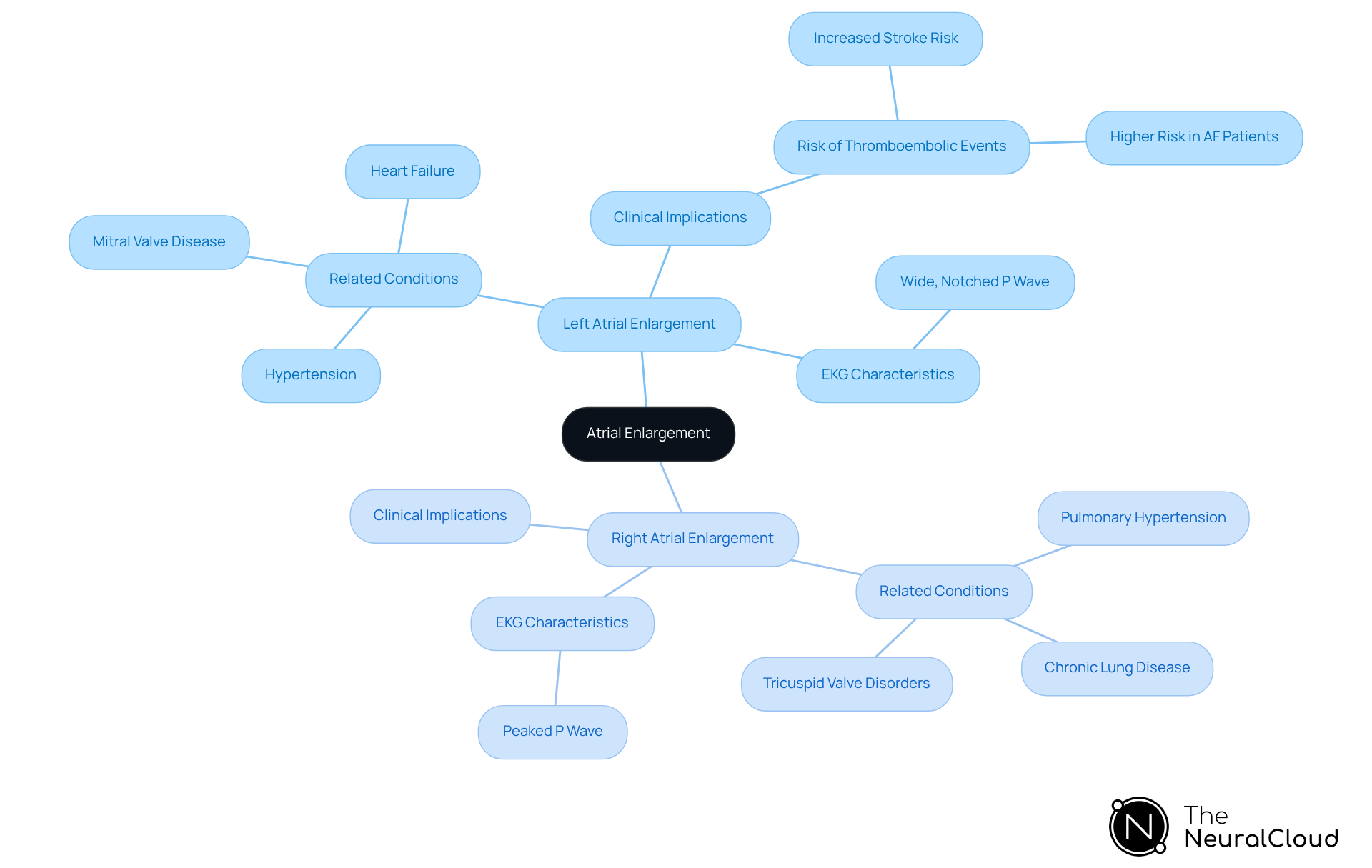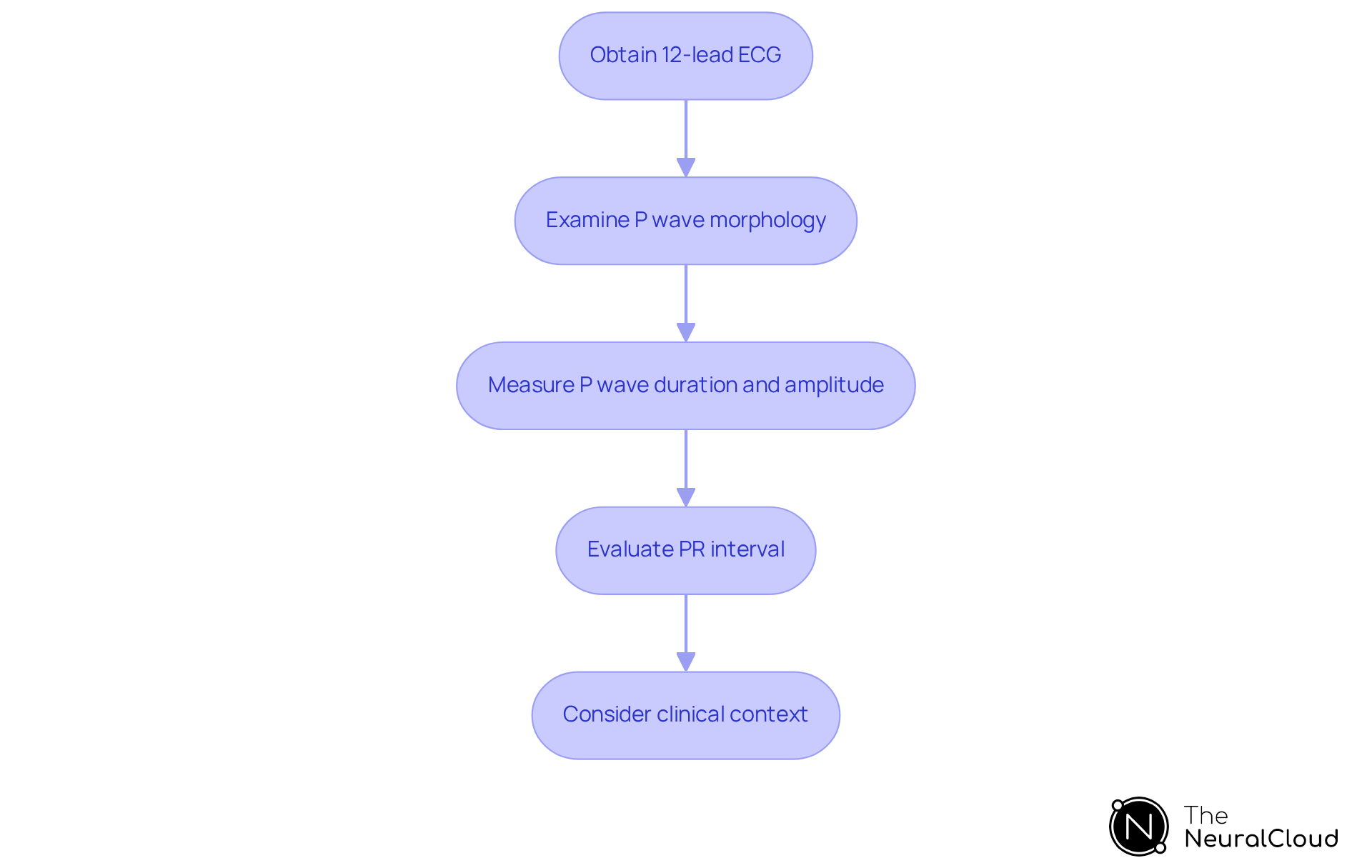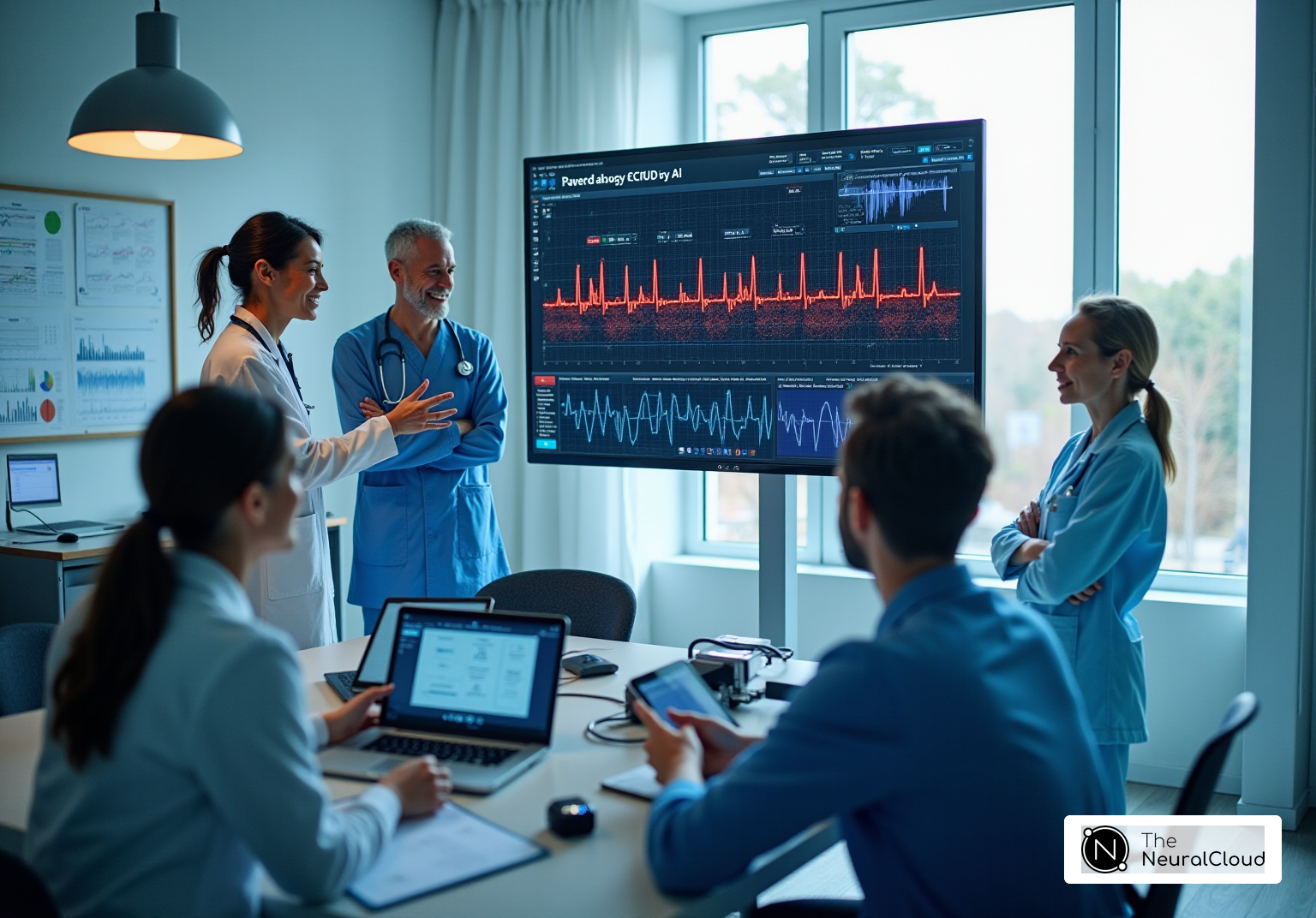Overview
Analyzing left atrial enlargement (LAE) on an EKG presents several challenges for healthcare professionals. Accurate identification of EKG patterns, such as the notched P wave indicative of LAE, is crucial for diagnosing heart conditions. However, traditional methods can be time-consuming and prone to errors, which can impact patient outcomes. This is where advanced technology, particularly the MaxYield™ platform, comes into play.
The MaxYield™ platform offers a range of features designed to enhance ECG analysis. It automates the identification of key EKG patterns, significantly reducing the time required for analysis. Additionally, the system filters out noise, allowing for clearer readings and more accurate diagnoses. By leveraging advanced algorithms, the MaxYield™ platform ensures that healthcare professionals can focus on what matters most—providing quality care to their patients.
The advantages of using the MaxYield™ platform are substantial. With improved diagnostic accuracy, healthcare professionals can make more informed decisions regarding patient treatment. This not only enhances patient outcomes but also streamlines the workflow within clinical settings. By integrating the MaxYield™ system into their practice, healthcare providers can elevate their ECG analysis capabilities, ultimately benefiting both their patients and their practice.
In summary, the MaxYield™ platform addresses the complexities of ECG analysis by offering automated, precise, and efficient solutions. Its features not only simplify the diagnostic process but also provide significant advantages for healthcare professionals, making it an essential tool in modern cardiology.
Introduction
Understanding the nuances of atrial enlargement is essential for accurate cardiac assessment. However, many healthcare professionals face challenges when interpreting EKGs. This article explores the complexities of left atrial enlargement (LAE) EKG analysis and emphasizes the significant role of advanced technologies, such as the MaxYield™ platform, in improving diagnostic accuracy. How can healthcare providers utilize these innovative tools to address traditional challenges in ECG analysis and enhance patient outcomes?
The MaxYield™ platform offers several key features that streamline ECG analysis. It provides advanced algorithms that enhance the detection of atrial enlargement, ensuring that healthcare professionals can make informed decisions quickly. Additionally, the platform integrates seamlessly with existing systems, allowing for efficient data management and analysis. These features not only simplify the interpretation process but also reduce the likelihood of errors, which is crucial in a clinical setting.
The advantages of using the MaxYield™ platform extend beyond just improved accuracy. By leveraging this technology, healthcare providers can save time in their diagnostic processes, allowing them to focus more on patient care. Furthermore, the platform's user-friendly interface makes it accessible for both seasoned professionals and those less familiar with EKG interpretation. This accessibility fosters a collaborative environment where all team members can contribute to patient assessments effectively.
In summary, the MaxYield™ platform addresses the complexities of ECG analysis by providing advanced features that enhance diagnostic accuracy and efficiency. By adopting this technology, healthcare professionals can overcome traditional challenges, ultimately leading to better patient outcomes. As the field of cardiology continues to evolve, embracing such innovations will be key to delivering high-quality care.
Define Atrial Enlargement: Left vs. Right
Atrial enlargement refers to the dilation of the atria, which can occur in either the left or right atrium due to various cardiac conditions. Left chamber enlargement (LAE) is often related to hypertension, mitral valve disease, and heart failure, whereas right chamber enlargement (RAE) is usually connected to pulmonary hypertension, chronic lung disease, or tricuspid valve disorders. Understanding these distinctions is vital, as they significantly influence treatment decisions and prognostic outcomes.
In the left atrial enlargement EKG, a wide, notched P wave in lead II is observed, indicating elevated left heart chamber pressure and volume. In contrast, RAE appears as a peaked P wave, indicating right chamber overload. Statistics indicate that LAE is common in more than 50% of individuals with atrial fibrillation (AF), emphasizing its significance in clinical practice. Moreover, substantial LAE, characterized by a left chamber anterior-posterior (LA A-P) measurement exceeding 47 mm in males and 43 mm in females, is linked to an increased risk of thromboembolic occurrences, even among individuals receiving anticoagulation treatment.
Real-world examples highlight the clinical importance of identifying cardiac enlargement. Research has indicated that individuals with considerable LAE have a 57% higher risk of stroke or systemic embolism compared to those without LAE. This correlation underscores the necessity for healthcare experts to correctly recognize and evaluate patterns of left atrial enlargement EKG on ECGs, as it directly influences treatment strategies and outcomes for individuals. Traditional ECG interpretation technology often struggles with noise and variability, which can hinder accurate diagnosis.
Neural Cloud Solutions' Continuous Learning Model addresses these challenges by evolving with each use, enhancing the efficiency and accuracy of ECG analysis. By mastering these distinctions and integrating advanced technologies like the MaxYield™ platform, health tech developers can significantly improve the diagnostic capabilities of their platforms, ultimately enhancing care for individuals.

Identify P Mitrale and P Pulmonale Characteristics
P Mitrale refers to the P wave morphology observed in left atrial enlargement EKG, characterized by a broad, notched appearance, often exceeding 0.12 seconds in duration. This pattern indicates delayed conduction through the left atrial enlargement EKG and is commonly associated with conditions such as mitral valve stenosis, mitral valve regurgitation, and hypertension. Research shows that left atrial enlargement EKG is prevalent in about 30-50% of hypertensive individuals, underscoring the importance of precise ECG analysis in monitoring cardiovascular health.
In this context, the MaxYield™ platform offers significant enhancements in ECG analysis. It automates the identification of P-wave morphologies and transforms noisy recordings into detailed insights. This capability allows for rapid and precise assessments, which are crucial for effective clinical decision-making.
In contrast, P Pulmonale is associated with right atrial enlargement, presenting as tall, peaked P waves, typically greater than 2.5 mm in height in lead II. This morphology is often observed in individuals with pulmonary hypertension or tricuspid stenosis. Recognizing these characteristics is essential for clinicians, as they provide immediate insights into the underlying cardiac conditions affecting the patient.
The MaxYield™ platform's ability to deliver beat-by-beat analysis and isolate key features, including P-wave, QRS complex, and T-wave intervals, in noisy recordings further emphasizes the need for healthcare professionals to be adept at interpreting these ECG features. This ultimately supports confident clinical decisions, enhancing patient care.

Analyze ECG for Atrial Enlargement: Step-by-Step Guide
Analyzing an ECG for left atrial enlargement can be challenging, but with Neural Cloud Solutions' MaxYield™, healthcare professionals can streamline this process effectively. This platform enhances ECG analysis by filtering out noise and artifacts, ensuring that recordings are clear and reliable.
To begin, obtain a properly calibrated 12-lead ECG. The MaxYield™ system excels in minimizing artifacts, which is crucial for accurate interpretation. Next, examine the P wave morphology, looking for characteristics of P Mitrale and P Pulmonale. The advanced wave recognition capabilities of MaxYield™ assist in identifying these features, even in difficult recordings, thus improving diagnostic confidence.
Measuring the P wave duration and amplitude is the next step. For P Mitrale, check for notching and a duration exceeding 0.12 seconds; for P Pulmonale, assess the height of the P wave in lead II. MaxYield™ automates the labeling of these measurements, enhancing efficiency and reducing the risk of human error. Additionally, evaluating the PR interval is essential, as a prolonged interval may indicate conduction delays linked to left atrial enlargement EKG. The adaptability of MaxYield™ ensures that it evolves with each use, continually enhancing diagnostic accuracy.
Finally, consider the clinical context by correlating findings with the individual's history and symptoms. By integrating wearable technology with advanced systems like MaxYield™, healthcare practitioners can optimize this process. This ultimately leads to improved outcomes through real-time data analysis and monitoring.
By following this structured approach and leveraging the capabilities of MaxYield™, healthcare professionals can significantly enhance diagnostic accuracy and optimize patient care.

Leverage Advanced Technology for Accurate ECG Analysis
ECG analysis faces several challenges, including the need for accurate identification of key features like P waves and QRS complexes. Advanced technologies, such as the MaxYield™ platform from Neural Cloud Solutions, address these issues by automating the analysis process.
Features of MaxYield™:
- AI Algorithms: These algorithms enable the platform to process vast amounts of data quickly and accurately.
- Rapid Analysis: MaxYield™ can analyze over 200,000 heartbeats in under five minutes, significantly reducing the potential for human error.
- Advanced Noise Filtering: This feature, combined with P, QRS, and T Wave highlighting, ensures that ECG signals are clear and interpretable.
Advantages for Healthcare Professionals:
By integrating MaxYield™ into clinical practice, healthcare professionals can enhance their diagnostic capabilities. The platform effectively addresses challenges such as physiological variability and signal artifacts, allowing clinicians to focus on delivering high-quality patient care. With timely and reliable insights, the MaxYield™ platform empowers healthcare providers to make informed decisions, ultimately improving patient outcomes.

Conclusion
Mastering the analysis of left atrial enlargement on EKG is crucial for healthcare professionals, as it significantly impacts diagnosis and treatment strategies. Understanding the differences between left and right atrial enlargement, along with the specific EKG characteristics associated with each condition, allows clinicians to enhance their diagnostic accuracy and ultimately improve patient outcomes.
The article explored various aspects of left atrial enlargement, including its definitions, the significance of P Mitrale and P Pulmonale characteristics, and a step-by-step approach to ECG analysis. However, traditional challenges in ECG interpretation can hinder effective diagnosis. This is where advanced technologies, such as the MaxYield™ platform, come into play.
Features of MaxYield™:
- Streamlined analysis process
- Enhanced clarity of EKG readings
- Improved reliability in ECG interpretation
These innovations not only simplify the analysis process but also bolster the confidence of healthcare professionals in their clinical decision-making. By leveraging the MaxYield™ platform, clinicians can navigate the complexities of ECG analysis with greater ease.
In conclusion, embracing advanced technology in EKG analysis is essential for the accurate identification and management of atrial enlargement. As the field of cardiology continues to evolve, healthcare professionals are encouraged to utilize tools like MaxYield™ to refine their diagnostic capabilities. By doing so, they can ensure that patients receive timely and effective care, ultimately leading to better health outcomes and reduced risks associated with atrial enlargement.
Frequently Asked Questions
What is atrial enlargement?
Atrial enlargement refers to the dilation of the atria, which can occur in either the left or right atrium due to various cardiac conditions.
What are the causes of left atrial enlargement (LAE)?
Left atrial enlargement is often related to hypertension, mitral valve disease, and heart failure.
What conditions are associated with right atrial enlargement (RAE)?
Right atrial enlargement is usually connected to pulmonary hypertension, chronic lung disease, or tricuspid valve disorders.
How can atrial enlargement affect treatment decisions?
Understanding the distinctions between left and right atrial enlargement is vital, as they significantly influence treatment decisions and prognostic outcomes.
How is left atrial enlargement identified on an EKG?
In left atrial enlargement EKG, a wide, notched P wave in lead II is observed, indicating elevated left heart chamber pressure and volume.
What does a peaked P wave indicate on an EKG?
A peaked P wave indicates right chamber overload, which is characteristic of right atrial enlargement.
How common is left atrial enlargement in individuals with atrial fibrillation?
Statistics indicate that left atrial enlargement is common in more than 50% of individuals with atrial fibrillation.
What is the significance of substantial left atrial enlargement measurements?
Substantial left atrial enlargement, characterized by a left chamber anterior-posterior measurement exceeding 47 mm in males and 43 mm in females, is linked to an increased risk of thromboembolic occurrences.
What is the risk associated with considerable left atrial enlargement?
Individuals with considerable left atrial enlargement have a 57% higher risk of stroke or systemic embolism compared to those without left atrial enlargement.
What challenges exist in traditional ECG interpretation?
Traditional ECG interpretation technology often struggles with noise and variability, which can hinder accurate diagnosis of atrial enlargement.
How does Neural Cloud Solutions' Continuous Learning Model improve ECG analysis?
The Continuous Learning Model evolves with each use, enhancing the efficiency and accuracy of ECG analysis, which helps in the diagnosis of atrial enlargement.
What role do advanced technologies like the MaxYield™ platform play in healthcare?
By integrating advanced technologies, health tech developers can significantly improve the diagnostic capabilities of their platforms, ultimately enhancing care for individuals with cardiac conditions.






